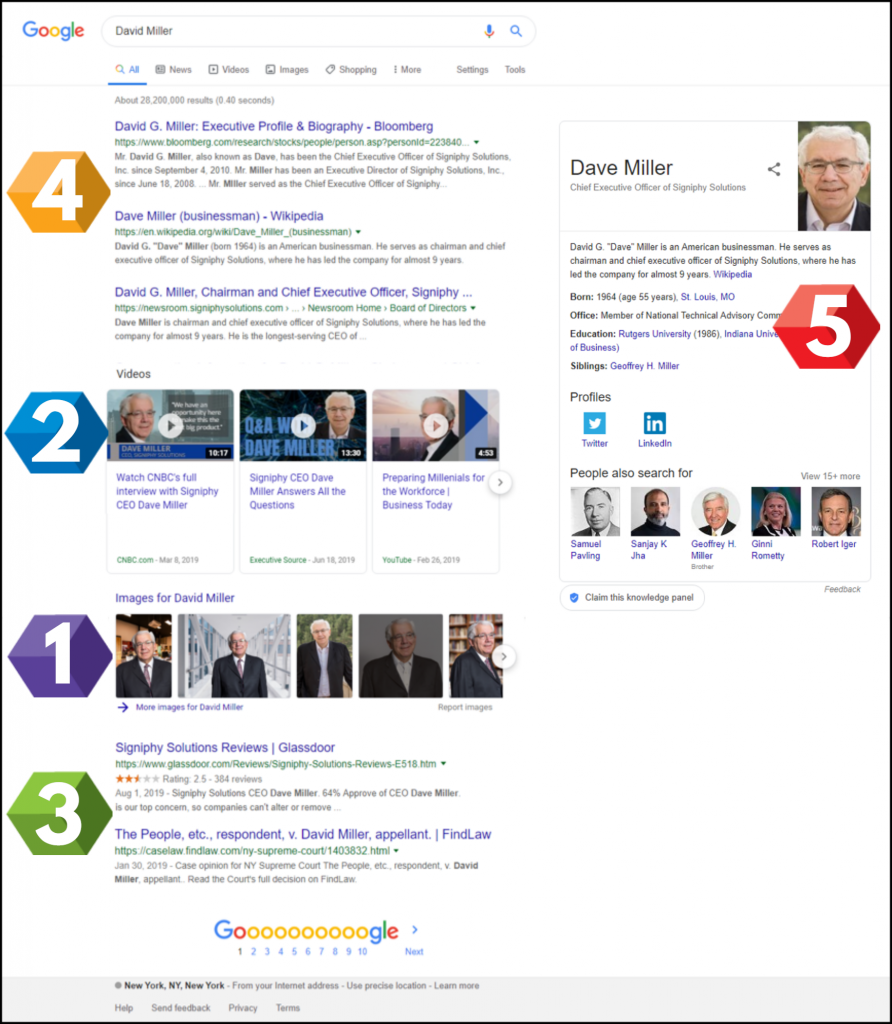So, what happens when they Google you?
What searchers think about a CEO’s search results
As an Intelligent Digital Reputation Management company, we are constantly doing research to understand how Google presents brands and executives in search. We also research how searchers utilize search engines to make decisions.
In August, we asked 672 US adults about their likelihood of doing business with Signiphy (a fictitious company) based on a provided set of search results – in visual form (see composite example below ) – for the (fictitious) CEO, Dave Miller.
Respondents were asked to imagine they were already considering doing business with the company and, as a next step, had decided to Google the CEO. Each participant was shown one of several variants of the search results page and was then asked to answer some questions about the page they saw.
Here’s what we found:
1 IMAGE BOX
This is intuitive – but it was borne out clearly in our research: Images on a search page help paint a picture in the searcher’s mind, more easily than any block of text, and affect how the searcher feels about the person they are searching.
We used images that depicted a CEO in a suit, smiling. He was evaluated as friendly and influential, and – notably – drove 80% more people to say they’d like him as a business partner compared to those who did not see the version with images. The majority of people, however, said they needed more information to decide.
Takeaway: Given how salient images are in searchers’ minds, well curated images can be a key factor in cultivating a favorable first impression.
2 VIDEO BOX
Video boxes take the impact of the visuals to another level. Like the image box, the video box in our study boosted impressions of the CEO as influential and friendly.
More than that, though, having a video box with favorable content helps solidify appeal of the subject for the searcher. Nearly 60% of people who saw the version with the video box indicated an increased likelihood to do business with the CEO’s company. Presence of the videos also boosted people’s sense that they had enough information to make a decision about doing business.
Takeaway: Videos that portray the CEO as a thought leader, hosted on known media (such as Forbes)– or even sites that appear to confer authority such as CNBC – are key in shaping searchers’ impressions of the CEO.
3 RATING SITES
Glassdoor is a site that allows current and former employees to rate their employer and its CEO. The site often appears on page one of Google search and is always shown with rating stars. Consequently, Glassdoor results are eye-catching and easier to quickly interpret compared to an all-text result.
The Glassdoor result in our research was shown with a mediocre 2.5 star rating. This led people who saw this result to be less likely to do business with the company, more so, in fact, than those who saw an all-text negative result about a pending lawsuit against the CEO.
People are used to seeing rating stars in searches for products and know to stay away when a product has few stars. That intuition transfers when rating stars are shown for a CEO, making Glassdoor an important result to watch.
Takeaway: If your brand has results with star ratings – Yelp, Glassdoor, or others – it is important to manage these and ensure that the star ratings are high – or alternatively that these results are not appearing prominently. Either way, brands need strategies aimed at managing these types of sites.
4 AUTHORITATIVE SITES
Bloomberg and Wikipedia are consistently among the most frequent sites to appear prominently in search results for CEOs. They typically appear toward the top of the page.
In our research, these two sites were the most frequently mentioned (in open ended replies) as the first places the searcher would click for more information.
Takeaway: Bloomberg and Wikipedia are deemed authoritative and trustworthy. This makes them an important component of a CEO’s digital presence.
5 KNOWLEDGE PANEL
As mentioned above, searchers’ attention will inevitably drift toward the visual, easily processed information on a search page. Even so, it is important to curate the text-only components of one’s search results. (This is especially true when there are fewer attention getting visual elements, where searchers are likely to take the time to read the text-based results.)
Our test pages mentioned both in the Wikipedia result and in the corporate bio that the CEO had been in that position for nine years. That information was duplicated in the knowledge panel blurb, which uses the first sentence from the subject’s Wikipedia page. People deemed that information useful and likely noticed it because it appeared in multiple places.
Takeaway: Curating search results by making sure key information appears in multiple authoritative online sources ensures that searchers will see desired information about the company or individual they are searching.

